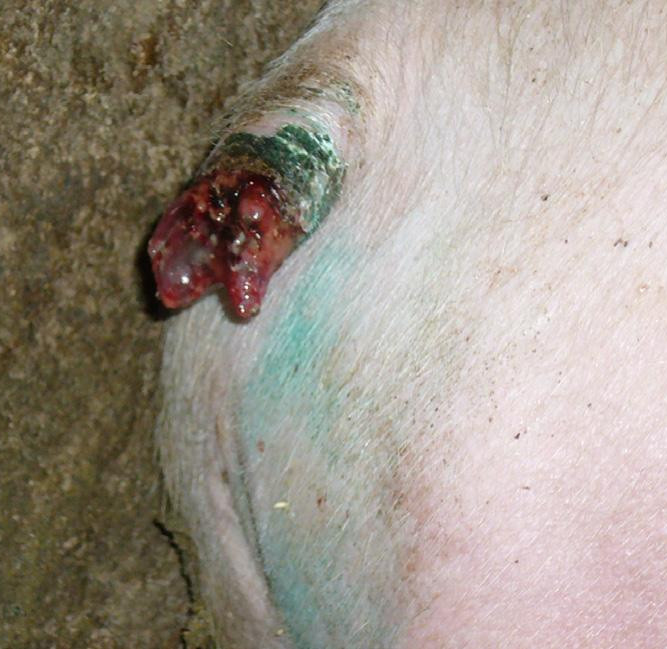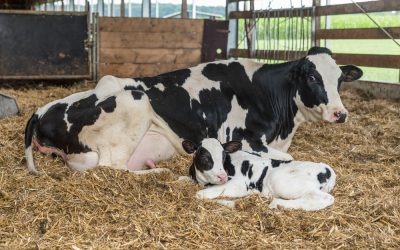D.Temple, E.Mainau, X.Manteca
More information
Download PDF Technical document
Tail biting represents both a major animal welfare and economic problem for the pig industry with losses due to reduced weight gain, increased on-farm veterinary treatment, culling and carcass condemnation. Tail biting has a multifactorial origin. It is known to be sporadic, making outbreaks difficult to predict and understand, even within the same facilities and under similar management systems. Nowadays, more than two third of the growing pig farms report some tail damage due to tail biting.
MAIN TYPES OF TAIL BITING
Tail biting can be described as any oral manipulation of the tail resulting in lesion and is usually referred as “abnormal” since it is rarely reported under extensive or semi-natural conditions.
Up to now, three main categories of tail biting behaviour associated to different motivational bases are described in the literature.
The first category, known as “two-stage” tail biting refers to a redirected exploratory behaviour. During the pre-damage stage, one pig gently holds the tail of another in its mouth without causing any damage to the recipient. This stage is considered to be a normal extension of pigs’ natural foraging and exploratory behaviour. The damaging stage appears as dental manipulation breaks the skin and makes the problem worse when other pigs are attracted to the tail. This stage does not have an aggressive motivation.
In the second category, known as “sudden-forceful” tail biting, a pig’s tail is seized and bitten forcefully without a clear prior period of gentle manipulation. It is more commonly seen when pigs are unable to access a desired resource such as food. This pattern follows a similar description to vulva biting in sows and anus biting and may be considered as an aggressive act due to frustration.
A third form of tail biting can be described as “obsessive” tail biting. Obsessive tail biters spend much more time biting tails than other tail biting animals. This abnormal behaviour might be comparable to stereotypies. Individuals that become obsessive tail biters are more likely to have undergone a growth deficiency during an earlier period and may therefore be smaller than expected.
As for the bitten animals, they are usually less reactive due to any painful condition or illness.
A bleeding tail stimulates the interest of other pigs in the pen and will be very attractive for further biting. The speed of the outbreak and its severity will depend on other pigs’ attraction to blood, on the diet and on the effectiveness of the stockpersons to identify and deal with the problem.

Bitten tails with severe injuries

Bitten tails with severe injuries
PRINCIPAL FACTORS IMPLICATED IN THE INCIDENCE OF TAIL BITING
The causes of tail biting are difficult to identify but many risk factors have been described in literature (see Table).
MAIN RISK FACTORS FOR TAIL BITING
- Lack of enrichment material and barren floors
- Poor ventilation-Large daily temperature fluctuations -High level of ammonia
- High stocking density and large herd
- Gastrointestinal discomfort
- Poor health status
- Suboptimal or imbalanced diet
- Individual factors (age, genetic)
According to European Food Safety Authority, the most important risk factor for an outbreak of tail biting is the lack of straw or other environmental enrichment in intensive systems.
Conditions that increase competition and frustration between pigs are likely to initiate a “sudden” form of tail biting. For example, competition for food or water will increase the potential for some pigs to become frustrated. Absence of food or a delay in its delivery is likely to lead to frustration and increased anxiety to feed once food is finally given. Unpredictable arrival of food can also act as a stressor. The number of feeding spaces as well as the management of food provision will affect the levels of frustration and competition and consequently the risk of tail biting.
Stress will increase the activity of the animals as well as their irritability. Any stressful situation may also contribute to the occurrence of tail biting. Temperature, the presence of certain gases, humidity and dust may act as stressors leading to increased discomfort and chronic stress. Thermal stress is a well known cause of tail biting. It is highly probable that tail biting will occur under long term inappropriate humidity and ventilation conditions. Increased incidence of tail biting is often reported in herds with poorer health, possibly due decreased reactivity of ill pigs to avoid tail biting. Chronic pain is also an important cause of discomfort and stress.
Ulcers and other gastro-intestinal disorders should be prevented. Several factors including the food texture (e.g. ground food), the size of food particles (<0.5mm) and the lack of fibre will increase the risk of gastric ulcers. This, in turn, will increase the motivation of pigs to chew and the risk of tail biting.
A suboptimal diet increases foraging behaviour and therefore the risk of “two stage” tail biting. Imbalances in the amino acid composition of the diet have been linked to tail biting and both deficits and excesses of protein may trigger tail biting. Finally, lack of salt in the diet and low levels of tryptophan in the diet increase the pigs’ preference for blood and therefore affect the development of outbreaks.
Genetic has also an influence on tail biting, especially at line/strain level.
PREVENTION – ENRICHMENT MATERIAL
Several studies have shown that pens with adequate enrichment materials have lower tail biting levels, especially the “two-stage” form of tail biting.
A range of objects such as chains or rubber hoses, and rooting materials such as straw, mushroom compost or maize silage have been studied. Pigs prefer objects that are ingestible, chewable and destructible. Pigs spend much more time manipulating straw than a hanging toy. Providing pigs with straw or other rooting material appear to reduce tail biting more effectively compared to enrichment such as toys, rope or chains. However, pigs quickly lose interest in all novel objects regardless of their physical properties. To be effective, rooting material should be clean and renewed frequently. When rooting material cannot be provided directly into the pen floor, it could be provided via a dispenser.
Since January 2003, the provision of appropriate environmental enrichment to pigs of all ages has been mandatory across the European Union. However, the Directive leaves considerable room for interpretation as it is not clear what “proper manipulation of the enrichment material means.
PREVENTION – MANAGEMENT STRATEGIES
Tail biting, particularly the “sudden” form, should also be prevented by identifying and avoiding situations which can lead to competitive or frustrating interactions between pigs. A range of factors will affect the level of competition between individuals for various resources including availability of food and water or preferred lying areas.
CONTROL – TAIL DOCKING
According to the EU legislation, tail docking is only allowed under veterinary prescription when tail biting remains a problem on the farm after preventive measures have been taken. However, tail docking is still considered a routine management procedure on intensive farms to prevent tail biting.
Tail docking tends to reduce the incidence of bitten tails under controlled conditions, but does not eliminate the abnormal behaviour. It is hypothesized that the nerve regeneration which follows docking creates hypersensitivity and pigs with docked tails will react more readily and more vigorously to pen mates chewing on their tails. Tail docking is suitable to treat the symptoms of tail biting behaviour but it does not resolve the causes of this abnormal behaviour. Tail docking makes the victim less likely to be severely bitten; however tail bitters will still present an underlying motivation to bite and therefore may redirect their behaviour to other parts of the body of the pen mates.
Behavioural parameters such as restlessness, foot stamping, head-turning, time spent in abnormal postures or vocalisation indicate that tail docking causes acute pain. Neuromas have been found in the tail stumps of tail docked pigs. Neuromas are bundles of nerve fibres that develop when axons are severed and cause increased sensitivity to pain at the site of the amputation, suggesting that these animals may experience increased sensitivity to pain due to tail docking.
“TAIL BITING SHOULD BE PREVENTED BY STIMULATING EXPLORATORY BEHAVIOUR TOWARDS MANIPULABLE SUBSTRATE AND BY IMPROVING THE PIGS’ ACCESS TO IMPORTANT RESOURCES”
SUMMARY
Tail biting represents a major challenge for the pig sector. It is a multifactorial problem with several underlying motivational causes. Prevention of tail biting should focus on the provision of adequate rooting material and avoiding any situation that causes competition, frustration and stress. Tail docking is suitable to control the symptoms of tail biting behaviour, but does not guarantee prevention of an outbreak. It should be kept as a temporary measure until environmental changes have been undertaken.
REFERENCES
- EFSA 2007 Scientific report on the risks associated with tail biting in pigs and possible means to reduce the need for tail docking considering the different housing and husbandry systems. The EFSA Journal, 611:1-13.
- Schrøder-Petersen DL, Simonsen HB. Tail biting in pigs. The Veterinary Journal 2001, 162: 196-210.
- Smulders D, Hautekiet V, Verbeke G, Geers R. Tail and ear biting lesions in pigs: an epidemiological study. Animal Welfare 2008, 17: 61-69.
- Taylor NR, Main DCJ, Mendl M, Edwards SA. Tail-biting: A new perspective. The Veterinary Journal 2010,186: 137-147.



